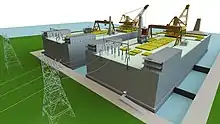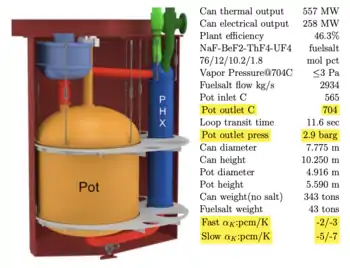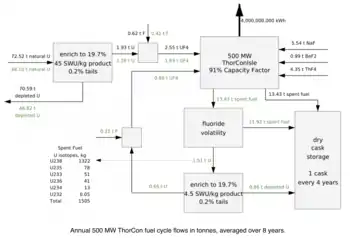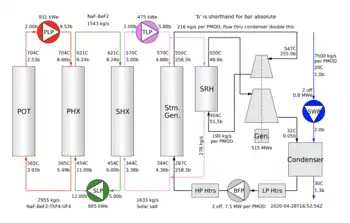ThorCon nuclear reactor
The Thorcon nuclear reactor is a design of a molten salt reactor with a graphite moderator, proposed by the US-based Thorcon company. These nuclear reactors are designed as part of a floating power plant, to be manufactured on an assembly line in a shipyard, and to be delivered via barge to any ocean or major waterway shoreline. The reactors are to be delivered as a sealed unit and never opened on site. All reactor maintenance and fuel processing is done at an off-site location. As of 2022, no reactor of this type has been built. A proposal to build a prototype in Indonesia has been submitted to the IAEA.[1]

Design


ThorCon proposed a power station closely based on the Molten-Salt Reactor Experiment in the 1960s. ThorCon claims its power stations require no new technology. They would contain two 250 MWe small modular reactors. The replaceable reactors are to be removed and replaced every four years. As molten salt reactors, they are designed for the use of fuel in liquid form, which also serves as primary coolant.[4] The fuel would be about 20% enriched uranium tetrafluoride and thorium tetrafluoride. The ThorCon is a floating power station to be build in a shipyard and then be towed to the location of operation.[5]
Safety

Thorcon claims that this reactor design will be safer than traditional nuclear reactors. The design includes several features intended to prevent meltdowns, contain radioactive materials, and protect from terrorism and sabotage.
Accidental overheating
The reactor includes a salt plug at the bottom of the vessel that will melt if the reactor gets too hot, allowing the fuel to flow out of the reactor and into drain tanks, where the fission reaction stops, and the decay heat is absorbed by a "cold wall".[7] No operator action is required, and there is nothing an operator can do to stop the safe shutdown. There are no electronic or electrical safety-critical systems or valves. Reactors that meet these requirements are called "walk-away safe".[8]
Leakage of radioactivity
The molten salt circulates at low pressure, and any leakage to the environment is blocked by three gas-tight barriers - the Can, the Silo, and the Hull.[9] The most troublesome fission products, including iodine-131, strontium-90 and cesium-137, are chemically bound to the salt. Tritium is captured by getters in inert gas in the power module hall and in the secondary heat exchanger cell; tritium penetrating the heat exchangers is captured by oxidation in the third salt loop.[10] Xenon and krypton radioisotopes bubble out in the header tank, are held in storage tanks until they have decayed to harmless levels, and are then cooled, compressed and stored.[11]
Sabotage
The hull is a 10ft thick wall of sand with an inch of steel on each side, capable of blocking a jumbo jet with eight-ton engines. Reactivity can be increased only by adding fuel slowly through an orifice inside the silo, out of reach of any rogue operator. The maximum rate of increase in reactivity is enough for load following, but never enough that the reactor can go prompt critical.[12] Should a group of terrorists seize control of the plant and attempt to remove fuel salt, they would require use of the 500-ton deck crane, which could be easily disabled with small artillery.[13] There is no vulnerability to cyber attack.
Waste management
The "high level waste" in the ThorCon fuel cycle can be used as fuel for future fast neutron reactors capable of efficiently burning thorium and depleted uranium. Such reactors and fuel resources could provide power for millennia.
Average per year for a 500 MW plant:[3]
High Level Waste: 13,400 kg to dry-cask storage[14]
Medium and Low Level Waste: 343 tonnes of irradiated steel (one of the 4 "cans") shipped out for refurbishment.
Recycled Fuel: 650 kg of 19.7% U-235 (33% of total U consumption)
Other: (Medical isotopes, etc.)
Weapons proliferation
The reactors are delivered as sealed cans and never opened on site. All reactor maintenance and fuel processing is done at a central secure location.
There is no online chemical processing to remove fission products or anything else, and no highly enriched material anywhere — none above 20% U-235.
The sealed cans are inside a high-radiation silo under a heavy concrete lid. Any attempt to get inside the silo can be detected by sensors and security cameras and stopped by local police or military.
Uranium is always low-enriched. Plutonium is always diluted with thorium, in fuel salt with hazardous fission products.[15] Making bombs from this material would be far more difficult than starting from uranium ore.
Cost
According to ThorCon, these nuclear reactors would produce cheaper electricity than from coal, gas, wind and solar, with electricity from a 500 MWe Thorcon power station costing $0.03 per kWh.[16]
Everything except the structure itself is replaceable. After four years of operation and four years of cooling, the sealed reactor can with the entire primary loop is returned to a centralized recycling facility, decontaminated, disassembled, inspected, and refurbished. This allows problems to be caught before they can turn into casualties. Thorcon plants with replaceable sealed reactors can operate for 80 years; but if a ThorCon is decommissioned, the process is little more than pulling out but not replacing all the replaceable parts.[17]
Specs for a 500MW plant:
Plant cost per kW: $1200
Operating cost per kWh: $0.03 (including $0.006 for fuel)
Fuel consumption per day:[18] 5.3 kg of 19.7% enriched uranium plus 9.0 kg of thorium.
-145 tonnes of natural uranium per GW-year compared to about 250 tonnes for a standard light water reactor
- future re-enrichment of spent fuel will cut this uranium requirement by a third
Inital fuel load (2 cans): 78,000 kg NaF-BeF2-ThF4-UF4 (76-12-10.2-1.8 mol %)
Reviews
A 2017 study by the Energy Innovation Reform Project looked at the ThorCon and concluded that "if power plants featuring these technologies are able to produce electricity at the average LCOE price projected here (much less the low-end estimate), it would have a significant impact on electricity markets.".[19]
Critiques
Union of Concerned Scientists report:
"Advanced" Isn't Always Better, Edwin Lyman (2021).
https://www.ucsusa.org/resources/advanced-isnt-always-better
“We studied the most prominent 'advanced' nuclear reactor designs. Unfortunately, few are safer or more secure than current generation reactors.”
From the Executive Summary:
“All MSRs chemically treat the fuel to varying extents while the reactor operates to remove radioactive isotopes that affect reactor performance. Therefore, unlike other reactors, MSRs generally require on-site chemical plants to process their fuel. MSRs also need elaborate systems to capture and treat large volumes of highly radioactive gaseous byproducts.”
From Jack Devanney, Principal Engineer, ThorCon USA Inc:
“For the record, ThorCon does no chemical processing online to remove fission products or anything else. Xenon and krypton bubble out in the header tank, are held in storage tanks until they have decayed to harmless levels, and are then cooled, compressed and stored. There's nothing elaborate or complex about the process.”
References
- IAEA Advanced Reactors Information System (ARIS) ThorCon_2020.pdf 2020/06/22.
- Fig.10 from Section 1.2 in ThorConIsle
- ThorCon Fuel Cycle
- Design. ThorCon webpage (retrieved April 2022)
- Status Report – ThorCon (Thorcon US, Inc.) USA/Indonesia, 22 June 2020
- ThorCon Power Conversion.
- The wall is kept "cold" by water that is replenished from a storage tank above the reactor. Circulation is maintained without pumps, because the hot water (or steam) rises in the space around the cold wall.
- https://thorconpower.com/wp-content/uploads/2019/03/ThorConSpecSheet7.pdf
- "Safety – ThorCon".
- https://thorconpower.com/wp-content/uploads/2019/03/ThorConSpecSheet7.pdf
- "Design – ThorCon".
- https://thorconpower.com/wp-content/uploads/2019/03/ThorConSpecSheet7.pdf
- Section 6.2 in https://aris.iaea.org/PDF/ThorCon_2020.pdf
- ThorCon power plants can store up to 80 years of used fuel onboard, using passive air cooling. ThorCon Fuel
- "ThorCon SpecSheet" (PDF).
- "Economics – ThorCon". Retrieved 2022-04-10.
- ThorConIsle, p.1; 3 March 2019
- "Fuel – ThorCon". Retrieved 2022-04-10.
- EIRP (July 2017). "What Will Advanced Nuclear Plants Cost?".
Further reading
- Mark Z. Jacobson (2020). 100% Clean, Renewable Energy and Storage for Everything. Cambridge University Press. ISBN 1108790836.
- Christopher Clack's Critique of Jacobson's 100% Renewables Proposal Proc. National Academy of Sciences 2017 114 (26) 6722-6727.
- Derek Abbott, Is Nuclear Power Globally Scalable? Proceedings of the IEEE, October 2011, pp.1611-17. A paper frequently quoted by anti-nuclear advocates, alleging fifteen "fundamental engineering and resource scaling limits that make the notion of a nuclear utopia somewhat impractical".
- Power to Save the World Gwyneth Cravens (2008). Power to Save the World - the truth about nuclear energy. Vintage Books. ISBN 978-0-307-38587-1.
- Lyman, Edwin (18 March 2021), "Advanced" isn't Always Better: Assessing the Safety, Security, and Environmental Impacts of Non-Light-Water Nuclear Reactors, Union of Concerned Scientists, pp. 97–98, doi:10.47923/2021.14000, S2CID 232275372
External links
- For more details see ThorCon's website ThorCon Design and ThorCon's Status Report to the IAEA for the Advanced Reactors Information System (ARIS) ThorCon_2020.pdf 2020/06/22.
- Presentation notes from Devanney at Virginia Commonwealth University
- Technical Summary from International Atomic Energy Agency
Copyright acknowledgement The material on Safety, Waste management, Weapons proliferation, and Cost has been copied under license CC-BY-SA from Citizendium.